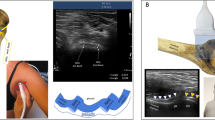Abstract
Objective
To identify shoulder magnetic resonance imaging (MRI) findings associated with surgically proven rotator interval abnormalities.
Materials and methods
The preoperative MRI examinations of five patients with surgically proven rotator interval (RI) lesions requiring closure were retrospectively evaluated by three musculoskeletal-trained radiologists in consensus. We assessed the structures in the RI, including the coracohumeral ligament, superior glenohumeral ligament, fat tissue, biceps tendon, and capsule for variations in size and signal alteration. In addition, we noted associated findings of rotator cuff and labral pathology.
Results
Three of three of the MR arthrogram studies demonstrated extension of gadolinium to the cortex of the undersurface of the coracoid process compared with the control images, seen best on the sagittal oblique images. Four of five of the studies demonstrated subjective thickening of the coracohumeral ligament, and three of five of the studies demonstrated subjective thickening of the superior glenohumeral ligament. Five of five of the studies demonstrated a labral tear.
Conclusions
The MRI arthrogram finding of gadolinium extending to the cortex of the undersurface of the coracoid process was noted on the studies of those patients with rotator interval lesions at surgery in this series. Noting this finding—especially in the presence of a labral tear and/or thickening of the coracohumeral ligament or superior glenohumeral ligament—may be helpful in the preoperative diagnosis of rotator interval lesions.









Similar content being viewed by others
References
Harryman DT II, Sidles JA, Harris SL, Matsen FA III. The role of the rotator interval capsule in passive motion and stability of the shoulder. J Bone Joint Surg 1992;74A:53–66.
Fitzpatrick MJ, Powell SE, Tibone JE, Warren RF. The anatomy, pathology, and definitive treatment of rotator interval lesions: current concepts. Arthroscopy 2003;19:70–9.
Rowe CR, Zarins B. Recurrent transient subluxation of the shoulder. J Bone Joint Surg 1981;63A:863–72.
Field LD, Warren RF, O’Brien SJ, Altchek DW, Wickiewicz TL. Isolated closure of rotator interval defects for shoulder instability. Am J Sports Med 1995;23:557–63.
Cole BJ, Rodeo SA, O’Brien SJ, et al. The anatomy and histology of the rotator interval capsule of the shoulder. Clin Ortho Relat Res 2001;390:129–37.
Morag Y, Jacobson JA, Shields G, et al. MR arthrography of rotator interval, long head of the biceps brachii, and biceps pulley of the shoulder. Radiology 2005;235:21–30.
Krief OP. MRI of the rotator interval capsule. AJR Am J Roentgenol 2005;184:1490–4.
Chung CB, Dwek JR, Cho GJ, Lektrakul N, Trudell D, Resnick D. Rotator cuff interval: evaluation with MR imaging and MR arthrography of the shoulder in 32 cadavers. J Comput Assist Tomogr 2000;24:738–43.
Bigoni BJ, Chung CB. MR imaging of the rotator cuff interval. Magn Reson Imaging Clin N Am 2004;12:61–73.
Tetro AM, Bauer G, Hollstien SB, Yamaguchi K. Arthroscopic release of the rotator interval and coracohumeral ligament: an anatomic study in cadavers. Arthroscopy 2002;18:145–50.
Gartsman GM, Roddey TS, Hammerman SM. Arthroscopic treatment of anterior–inferior glenohumeral instability: two to five-year follow-up. J Bone Joint Surg 2000;82A:991–1003.
Ho CP. MR imaging of rotator interval, long biceps, and associated injuries in the overhead-throwing athlete. Mag Reson Imaging Clin N Am 1999;7:23–37.
Author information
Authors and Affiliations
Corresponding author
Rights and permissions
About this article
Cite this article
Vinson, E.N., Major, N.M. & Higgins, L.D. Magnetic resonance imaging findings associated with surgically proven rotator interval lesions. Skeletal Radiol 36, 405–410 (2007). https://doi.org/10.1007/s00256-006-0250-x
Received:
Revised:
Accepted:
Published:
Issue Date:
DOI: https://doi.org/10.1007/s00256-006-0250-x




